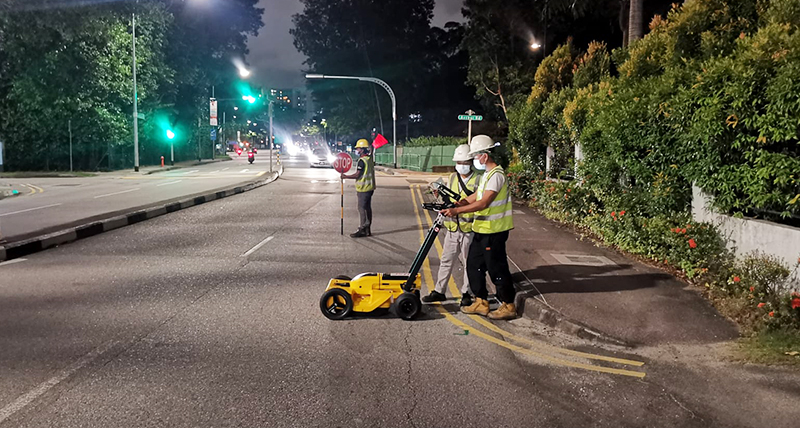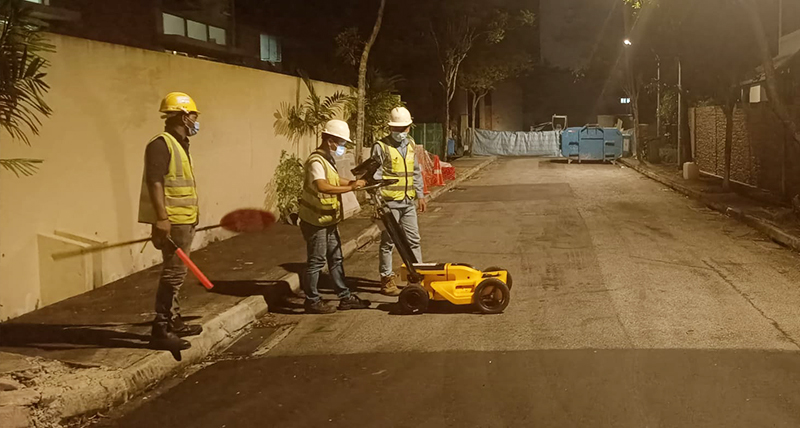GPR for Underground Truth Brings Business Benefits
Customer Story

Expanding and maintaining Singapore’s vast and complex underground infrastructure safely and with minimal disruption is a large undertaking, but one that HSC Pipeline Engineering (HSC) is dedicated to as a leading contractor for public and private utilities companies in Singapore.
One key component of their success is accurate underground truth for assessments that optimise planning, refine designs and ensure safe excavations and installations. Leica Geosystems ground penetrating radar (GPR) detection solution featuring the Leica DS2000 has transformed the way HSC conducts utility surveys, minimising disruptions from digging, saving costs and time and allowing HSC to do more with their existing resources.
Supporting Singapore’s urban development with underground truth
A population of 5.45 million coupled with limited land availability means that urban development projects in Singapore must leverage underground spaces effectively, supporting existing utility infrastructure while initiating expansion. However, utilising subsurface spaces requires certainty about the underground situation to enable accurate planning, reduce project times and ensure resident and worker safety during construction.
Within this landscape, HSC has emerged as a trusted partner for private and public utility companies, completing pipeline projects across Singapore. With over 29 years of experience and the consistent integration of new technologies and methods into their service offerings, HSC provides expertise across industries at all project stages, from feasibility and planning to construction and pipeline installations.
One common element across their projects is the need to establish underground truth using utility surveys, determining the precise location, depth and size of existing pipelines and cables.
“The underground utilities network of Singapore is extensive, complex and ever growing,” says Shane Shi, Managing Director of HSC. “As a government contractor that lays new utilities and repairs existing ones, HSC requires accurate underground truth to plan, deploy and execute our daily operations.”
Replacing survey trenches with GPR technology
HSC’s long history of project success is connected to their forward-looking and technology-driven approaches, including optimising the acquisition of underground detection data. Traditionally, utility surveyors have been highly dependent on digging trial holes – survey trenches that allow an assessment of the underground area. However, this method is disruptive, requires significant resources and can pose potential hazards.
“Digging trenches just for surveys is too cost and labour intensive,” Shane explains. “HSC requires non-destructive techniques to achieve high quality subsurface utility engineering and to determine what is underground and where to conduct operations.”
As a result, HSC decided to add GPR to their utility survey workflow with the goal of reducing trial hole dependence while improving data quality.
“The non-destructive surveying method afforded by GPR brings data acquisition closer to real time and covers far greater areas than is possible with static trial holes,” says Shane.
To pursue the transition to GPR, HSC selected a Leica Geosystems’ detection solution, including the Leica DS2000 and the Leica GS18 T, along with a third-party GPR imaging software.
The DS2000 is a utility detecting radar that can find buried assets, including non-conductive pipes and fibreoptics, at a variety of depths simultaneously. When used in conjunction with the GS18 T smart antenna, a GNSS RTK rover, the radar scans are enhanced with precise, georeferenced location data.
Already familiar with Leica Geosystems products and the Leica Singapore team, HSC was confident in the quality of the instruments and strong customer support.
Shane reflects on some of the key product selection factors: “The intuitive design and operation of the DS2000 for rapid onsite analysis and the easy transfer of data for processing were important. We also considered the georeferencing accuracy from the GS18 T and the ability to link GNSS and GPR together into one streamlined workflow.”
GPR-GNSS integration: Speedy setup and strong results
While the data collection enabled by the DS2000 and GS18 T is advanced and sophisticated, setup and training were relatively easy and simple thanks to the intuitive features of the instruments and local training support.
“The team from Leica Singapore helped ease us into using GPR for our daily operations, including improving the GNSS-GPR integration and supporting our efforts to include GPR scanning on a much larger scale,” says Shane.
Within a week, the HSC team was able to use the DS2000 to collect actionable data. After the first month, they had learned advanced techniques to formulate processing workflows for complex data. Collecting GPR B-scans with the DS2000 and gathering georeferenced data with the GS18 T, they were able to create GPR C-scans, or time slices, by combining the data into a GPR visualisation software.
The new workflow solution has had a significant impact on HSC’s operations, resource management and deliverables. Before integrating the DS2000 solution into their utility detection process, HSC dug an average of 33 trial holes monthly, each costing SGD 2,800 and consuming 1400 workhours.
However, these numbers have drastically changed. “Since the introduction of GPR with the DS2000 in December 2020,” Shane reports, “HSC has reduced the number of trial holes dug each month by approximately 30%, translating to a monthly cost savings of SGD 30,800.
” Workhours required to perform utility surveys have also dropped, allowing personnel to be reassigned to other revenue-generating activities, like pipelaying and repairs. HSC plans to continue using the Leica Geosystems detection solution, increasing integration into their utility survey process to further reduce trial hole reliance.
Using GPR data for individual projects and a common platform
Reflecting on the investment and integration of the DS2000 and GS18 T into their detection workflow, Shane notes that “the solution is easy to employ and creates value almost immediately in terms of reducing overheads and improving underground truth accuracy.
” However, the benefits extend beyond their own business. HSC plans to expand the use of the collected data to create a common platform for stakeholders, enabling more informed decisions. This platform will provide a more comprehensive collection of underground truth, ultimately helping support the maintenance and expansion of Singapore’s subsurface infrastructure.
The DS2000 and GS18 T are now part of the toolset HSC uses to progress the quality, efficiency and processes of their pipeline engineering services. “We are adopting powerful technologies, like the Leica GPR detection solution, to redefine how work can be done,” Shane concludes.





























